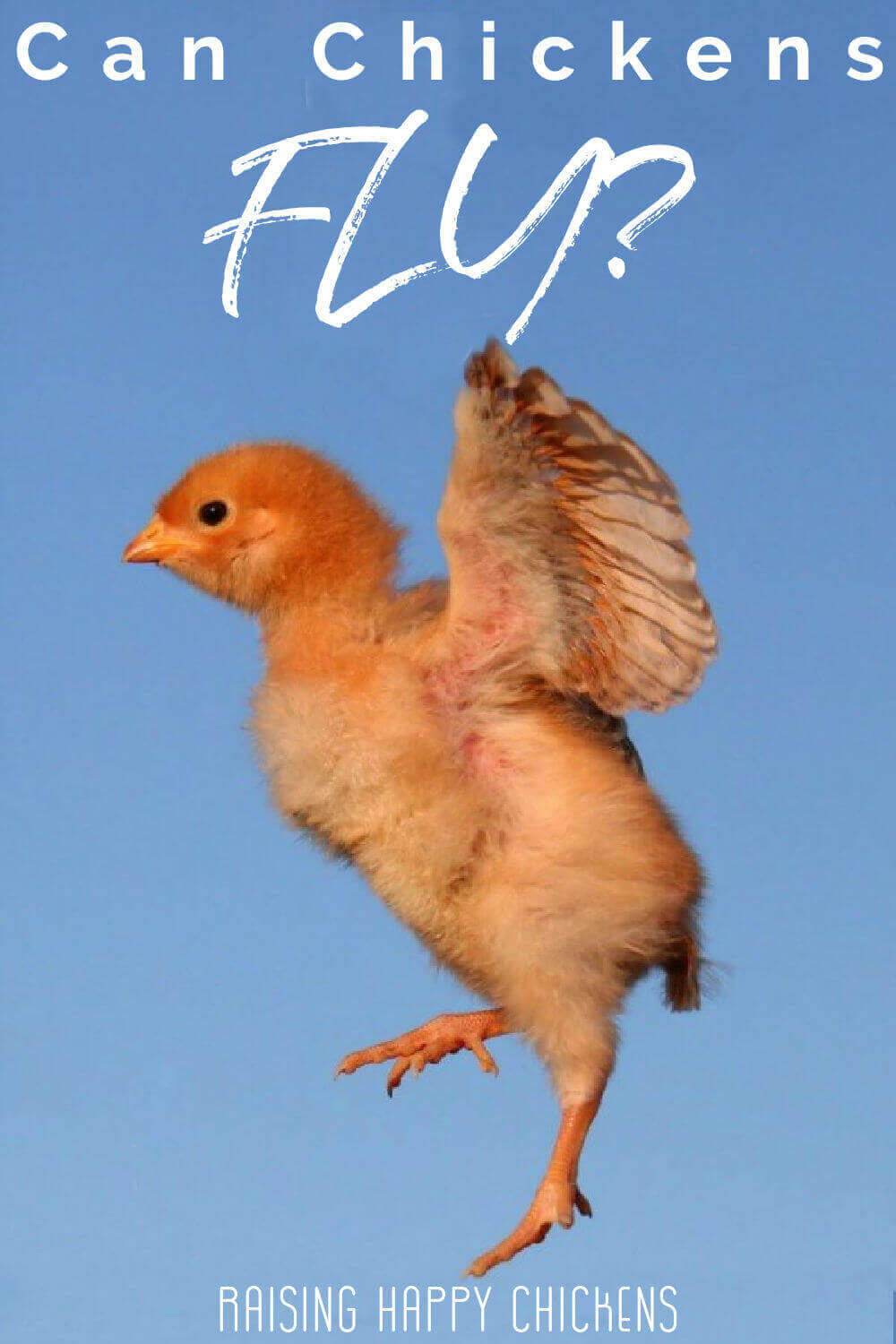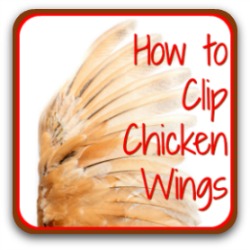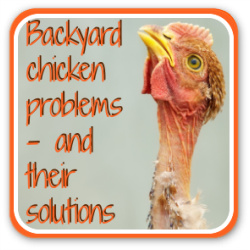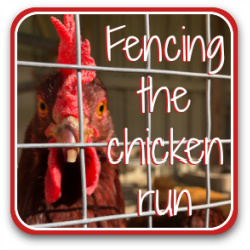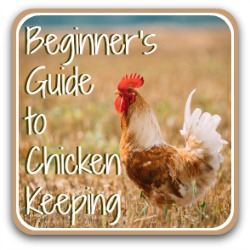- Home
- Challenges
- Flying
Can chickens fly?
Ever wondered how it is that you put your flock in their run in the morning and by the time you've finished breakfast they're all over your back yard?
You're standing there asking yourself "how in the world did that happen?"
There's a simple explanation. Chickens can fly! They're not good at it, they can't fly high and they can't fly far, but they will, if given the chance, test their wings from a very young age.
Can wild chickens fly?
Yes, originally the wild chicken could fly, though not high and not far.
It's a matter of survival.
Our domesticated birds are descended from the wild red and grey jungle fowl of Asia. In the wild, it's completely natural for them to fly – although they prefer to eat from the ground.
They use their wings to escape predators, and to roost in trees at night.
If you've ever had light-bodied hens who have not got into the roost in time at night, you'll often find them sitting quite happily in a tree nearby. It's the remains of that inherited instinct to roost off the ground.
But "fly" has to be seen in context. Even jungle fowl cannot fly in anything like the same way as we think of garden birds or birds of prey flying, for example.
So let's look at what "flying" chickens can actually manage.
Why can't chickens fly if their ancestors could?
Domesticated chickens have been bred selectively over time. The 'flight muscles' are what we know as the breast. And because chickens have been bred largely for food, they've been bred to have large areas of edible meat: the pectoral muscle, better known as the chicken breast(1, 2).
So it's become too large and heavy for a chicken to be able to fly comfortably. They just don't have the endurance.
The exception to this is very young chicks. If you've ever incubated your own, you'll have found that they try out their wings at a very early age in the brooder – well before they start to develop physically.
How high can chickens fly?
There's no officially recorded height for a chicken flight.
My Red Stars are the most determined when it comes to flying, with Leghorns a close second. I have seen both those breeds "fly" over a fence of about six feet.
But heavier breeds won't be able to get anything like that high.
My Light and Speckled Sussexes, Wyandottes and Orpingtons, for example, don't bother trying to fly at all.
Adult Silkies don't have strong enough flight feathers, but as chicks, like all chicks, they love to test their wings from an early age.
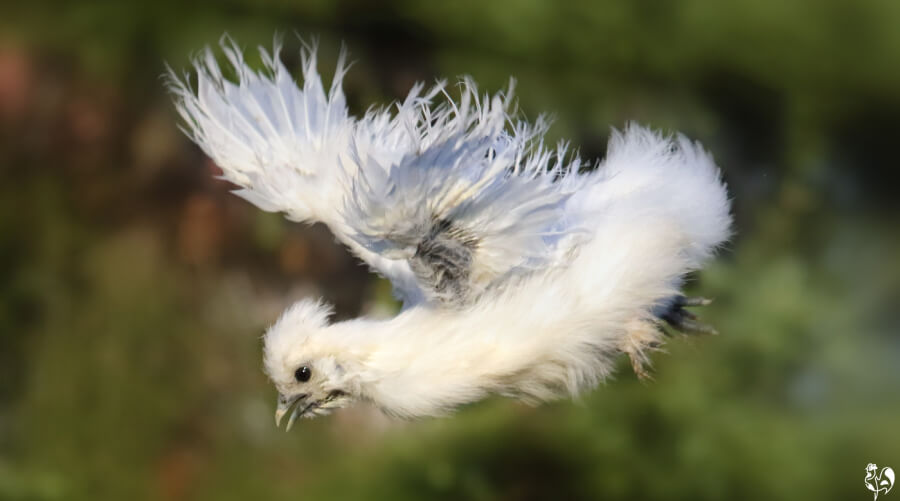 Chicks will test their wings from a young age.
Chicks will test their wings from a young age.My Polish just watch with disdain. They think that flying is something less cultured birds do.
But for those breeds that like to fly, four feet is relatively easy for them, for a very short distance. Six is getting more difficult but still possible, even for the medium sized birds.
How far can chickens fly?
Not far. The official record for the furthest poultry flight was recorded in 1985(3). A bantam chicken flew for a distance of 192.07 metres (630 feet, 2 inches) – but that's very unusual.
Naturally speaking domestic chickens aren't good flyers: their wings are too small and those flight muscles (the pectorals), as we've seen, are too large and heavy. Those two factors alone make it hard for them to take off(1).
And even if they do manage some height, their body weight is generally too heavy for the wings to carry them any distance. So rather than flying in the way that garden birds can, for example, chickens tend to do a kind of hop and flap motion.
It's not terribly elegant!
Left to themselves, they'll generally stay on the ground where they can forage for food. But they'll fly if they have to: to escape predators, to roost, to get out of their run onto open land.
And occasionally, in my experience, just to prove who's boss!
Trust me, it's not easy persuading a chicken to come down from a 30 foot high bay tree at dusk. My Wyandotte, Miss Marple, was just showing me she could call the shots...
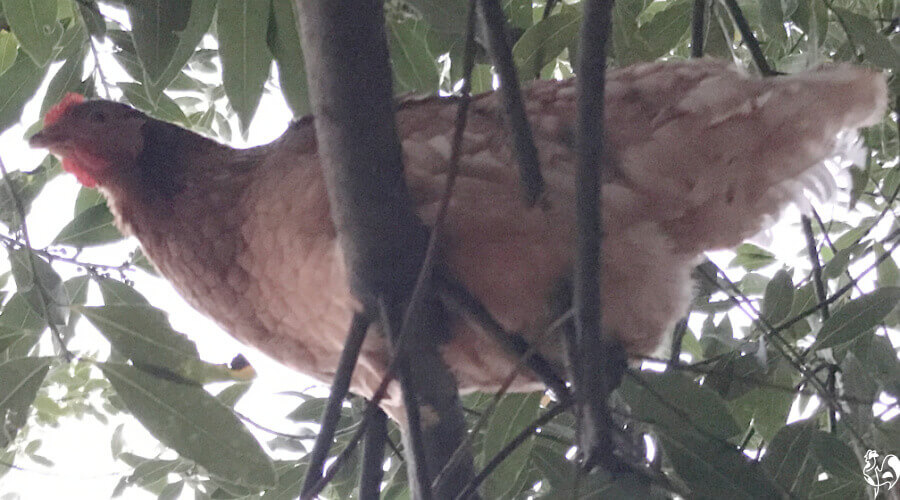
Can chickens fly over fences?
They can.
Fencing a chicken run in the right way can make it more difficult for heavier breeds, but lighter breeds and bantams will fly over 6 foot fences with little problem.
In fact, some of my own Red Stars "flew" over my six foot high fence even after they'd had one wing clipped. Everything I'd read said they shouldn't be able to fly with one wing clipped.
I didn't know how they were doing it – until I sat and watched them.
They hopped onto a branch which took them about halfway up the fence. Then, they flapped their wings for long enough to fly over to the other side.
They were lopsided and they weren't terribly elegant in the way they landed. But they did it.
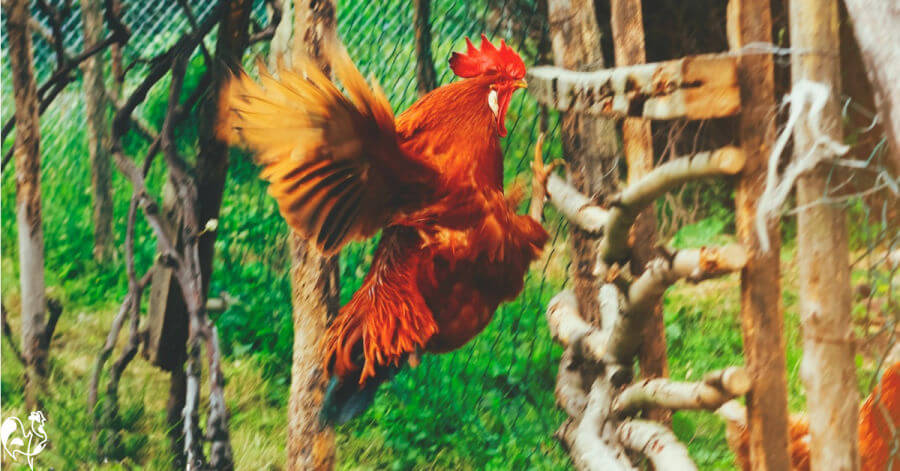 A low fence is no barrier for a determined chicken!
A low fence is no barrier for a determined chicken!At what age can chickens fly?
From when they're just a couple of days old, chicks develop wing feathers. And as little chicks, their body weight is light enough to start experimenting with using them.
This little Wyandotte chick was flying around the room like an expert at just over one week old! In this photo, she was just four days old and already had well developed wing feathers.
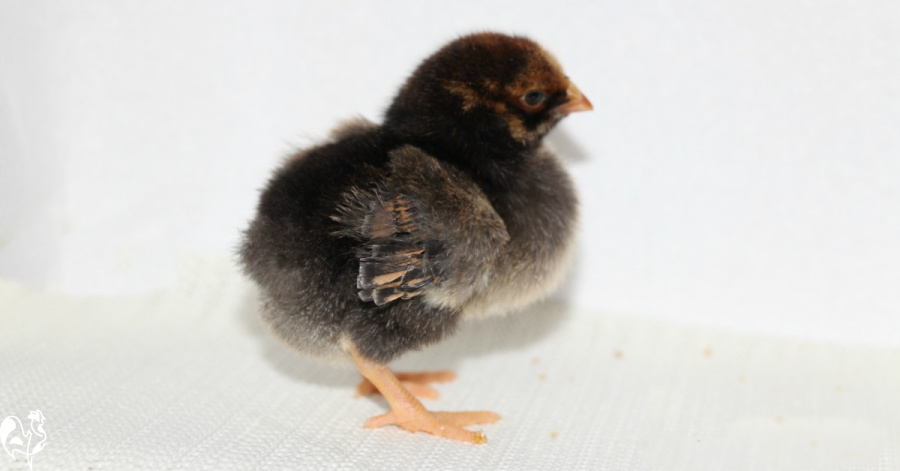 One of my Wyandotte chicks at just 4 days old. See how well her wings are already growing?
One of my Wyandotte chicks at just 4 days old. See how well her wings are already growing?Depending on the breed, the flight feathers (the long feathers on the leading edge of the wing) start growing at day three or four after hatching and are fully developed by the age of between five and ten weeks.
Which chicken breeds can fly?
Technically most can, but not all choose to. Some prefer it more than others and some are just too heavy ever to get their bodies off the ground.
Bantams are the best flyers: their small body makes it easier for them to take off! My bantam Sablepoots often roost in trees rather than joining the large breeds in the coop at night.
Lighter bodied breeds such as Araucanas are good flyers, and some just seem to enjoy flying. My own hybrid Red Stars just love to fly.
On the other hand my Leghorns, which are quite light, are happier foraging on the ground rather than flying.
Heavier birds such as Orpingtons, Barred Rock and Australorp can't usually get the energy together and 'fancy' breeds like Polish seem not to want to get their feathers ruffled in flight!
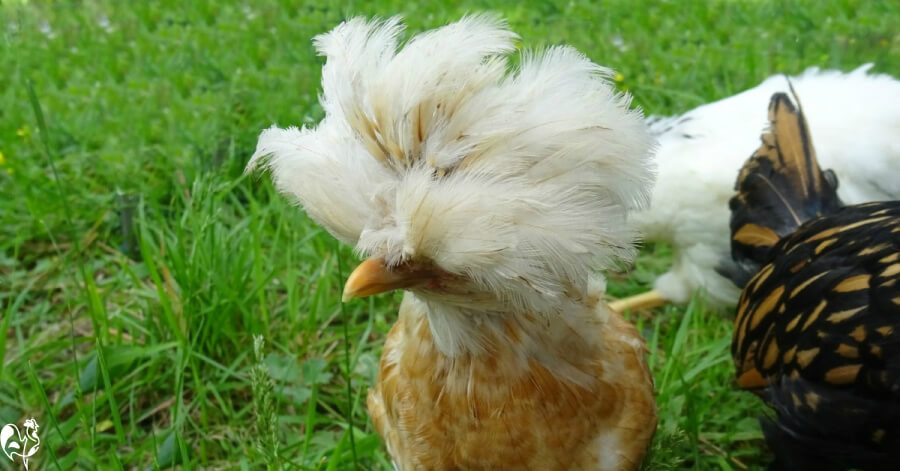 My Polish chickens never wanted to fly even when they were very young.
My Polish chickens never wanted to fly even when they were very young.Can chickens fly? What the answer means for you.
If you live in a town and have a few hens in your back yard, your neighbours might not be terribly pleased that their lovely green lawn is being raked over by your marauding flock.
Hens are ruthless when it comes to grass. They can clear a patch in minutes and turn the run into a mud bath!
And neighbours definitely won't be pleased that your girls have chomped down on their veggie patch, or used their lovely summer flower pots as dust baths.
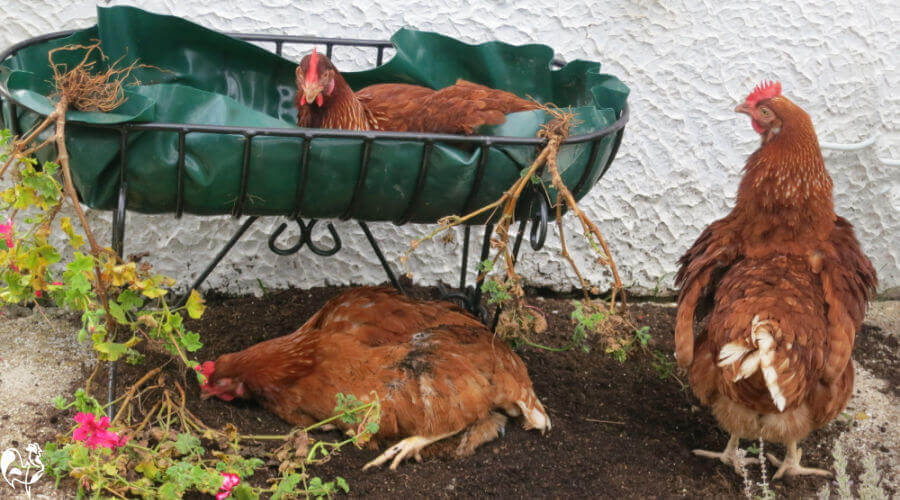 My chickens turn my summer flower displays into a chicken spa!
My chickens turn my summer flower displays into a chicken spa!More importantly for your flock, though, is that flying can actually put them in danger.
Here's a story to explain why.
Lulu's story.
I had a problem. My Red Star chickens love to free range – we have a lot of land – but our neighbour's dogs were constantly roaming onto our property and my flock was not safe.
I thought I could manage it by supervising them. And then, one day, the dogs got little Lulu.
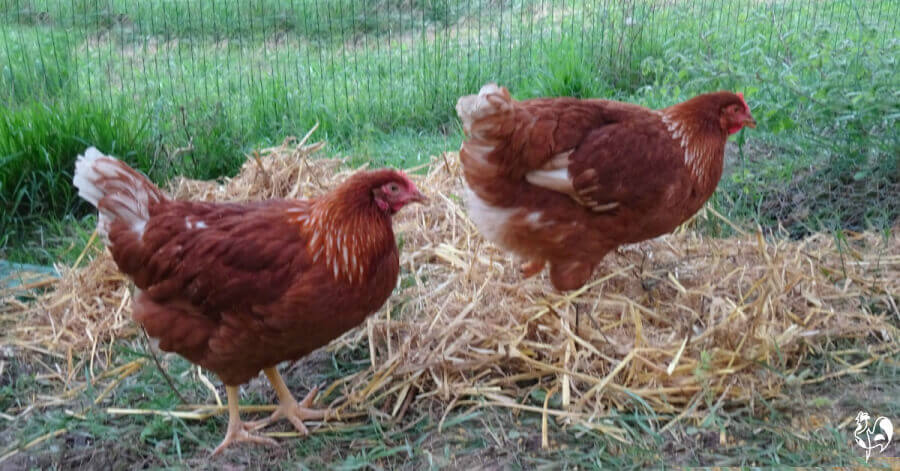 Two of my Red Stars. Lulu, on the right, lost her tail feathers in a dog attack.
Two of my Red Stars. Lulu, on the right, lost her tail feathers in a dog attack.I was lucky: I got to her in time and although she was badly bitten (and as you can see she lost a lot of tail feathers), she survived.
So I began to keep the flock in their run.
But the girls weren't happy. You know what they say: the grass is always greener on the other side of the fence.
They liked their run, but they liked to free range more.
So they flew. Red Stars are well known for it.
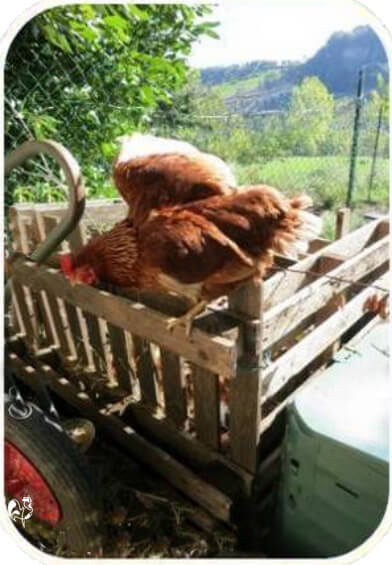
They flew over a six foot high fence. They flew in the morning and they flew in the afternoon.
I clipped one wing and they learned to fly with the other. I clipped both wings, and they hopped. Chickens can hop a long way, it seems.
I put them back in their run and they flew out again.
I tried to catch them and they flew into trees. I got them down and they perched on the roof.
Which proved to me beyond all doubt that not only can they fly – many chickens will do so at any given opportunity. It's in their nature.
And that's all fine except for ... well, you get the picture.
This is a pic of Claudia, who managed to get over the six foot fence with one wing clipped and landed safely on the compost heap.
There was only one solution...
What are the possible solutions for chickens who fly?
Flying hens can be fun to watch, but they can cause problems, too.
Unhappy neighbours, plants and
vegetable gardens destroyed, and worst of all, putting
themselves at risk of attack from the waiting mouths of predators.
What can you do?
There are different options available.
One is to put a cover – netting, for example – over the top of your run. That's entirely possible, depending on its size.
Another option is to clip their wings. Personally, I don't like taking any part of the body away from a living creature.
But a six foot fence didn't stop them flying into danger, and my run is much too big to cover with netting.
So it was the only option to prevent my chickens from constantly flying into danger.
It's not the answer for everyone, but it worked for me and it's worked for a lot of people who have watched my video of how to do it safely.
See the video and read more about exactly how easy it is to clip chickens' wings.
And be reassured: it doesn't hurt them a bit, any more than clipping your toenails hurts you.
Other articles you may find useful.
Sources.
A lot of "facts" you'll find on the internet are often people's individual views, based on inaccurate information repeated from poor quality sources.
The information I provide in this article and others is based not just on my own experience, but on evidenced facts from scientific, peer-reviewed research and books from highly respected and experienced poultry keepers such as Gail Damerow.
Some of the trusted sources I have used in this article are these.
1. Geggel, Laura: Why Are Chickens So Bad at Flying? Pub. Live Science, 2016.
2. Del Valle, A. L.: Why Can’t Chickens Fly? Pub. Pennsylvania State University, 2016.
3. Guiness World Records, Longest Poultry Flight, 1985.
- Home
- Challenges
- Flying
